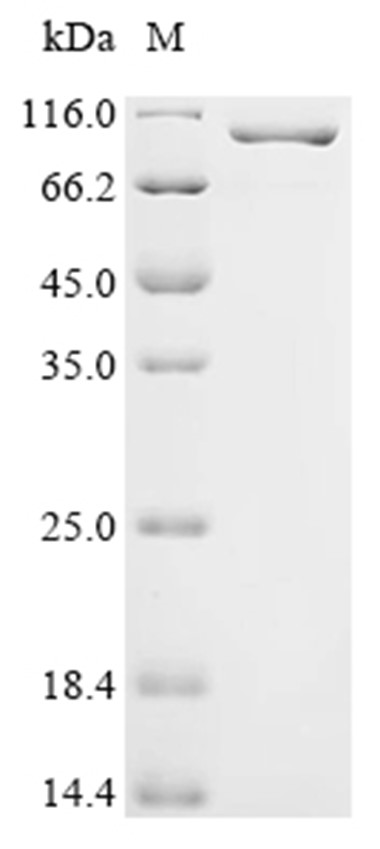 Your shopping cart is currently empty
Your shopping cart is currently empty
gyrA Protein, E. coli, Recombinant (His)
A type II topoisomerase that negatively supercoils closed circular double-stranded (ds) DNA in an ATP-dependent manner to maintain chromosomes in an underwound state. This makes better substrates for topoisomerase IV (ParC and ParE) which is the main enzyme that unlinks newly replicated chromosomes in E.coli. Gyrase catalyzes the interconversion of other topological isomers of dsDNA rings, including catenanes. Relaxes negatively supercoiled DNA in an ATP-independent manner. E.coli gyrase has higher supercoiling activity than many other bacterial gyrases; at comparable concentrations E.coli gyrase introduces more supercoils faster than M.tuberculosis gyrase, while M.tuberculosis gyrase has higher decatenation than supercoiling activity compared to E.coli. E.coli makes 15% more negative supercoils in pBR322 plasmid DNA than S.typhimurium; the S.typhimurium GyrB subunit is toxic in E.coli, while the E.coli copy can be expressed in S.typhimurium even though the 2 subunits have 777/804 residues identical. The enzymatic differences between E.coli gyrase and topoisomerase IV are largely due to the GyrA C-terminal domain (approximately residues 524-841) and specifically the GyrA-box.; Negative supercoiling favors strand separation, and DNA replication, transcription, recombination and repair, all of which involve strand separation. Type II topoisomerases break and join 2 DNA strands simultaneously in an ATP-dependent manner.

gyrA Protein, E. coli, Recombinant (His)
| Pack Size | Price | USA Warehouse | Global Warehouse | Quantity |
|---|---|---|---|---|
| 5 μg | $129 | 20 days | 20 days | |
| 10 μg | $216 | 20 days | 20 days | |
| 20 μg | $360 | 20 days | 20 days | |
| 50 μg | $543 | 20 days | 20 days | |
| 100 μg | $745 | 20 days | 20 days | |
| 200 μg | $1,070 | 20 days | 20 days | |
| 500 μg | $1,730 | 20 days | 20 days | |
| 1 mg | $2,530 | 20 days | 20 days |
Product Information
| Biological Activity | Activity has not been tested. It is theoretically active, but we cannot guarantee it. If you require protein activity, we recommend choosing the eukaryotic expression version first. |
| Description | A type II topoisomerase that negatively supercoils closed circular double-stranded (ds) DNA in an ATP-dependent manner to maintain chromosomes in an underwound state. This makes better substrates for topoisomerase IV (ParC and ParE) which is the main enzyme that unlinks newly replicated chromosomes in E.coli. Gyrase catalyzes the interconversion of other topological isomers of dsDNA rings, including catenanes. Relaxes negatively supercoiled DNA in an ATP-independent manner. E.coli gyrase has higher supercoiling activity than many other bacterial gyrases; at comparable concentrations E.coli gyrase introduces more supercoils faster than M.tuberculosis gyrase, while M.tuberculosis gyrase has higher decatenation than supercoiling activity compared to E.coli. E.coli makes 15% more negative supercoils in pBR322 plasmid DNA than S.typhimurium; the S.typhimurium GyrB subunit is toxic in E.coli, while the E.coli copy can be expressed in S.typhimurium even though the 2 subunits have 777/804 residues identical. The enzymatic differences between E.coli gyrase and topoisomerase IV are largely due to the GyrA C-terminal domain (approximately residues 524-841) and specifically the GyrA-box.; Negative supercoiling favors strand separation, and DNA replication, transcription, recombination and repair, all of which involve strand separation. Type II topoisomerases break and join 2 DNA strands simultaneously in an ATP-dependent manner. |
| Species | E. coli |
| Expression System | E. coli |
| Tag | N-6xHis |
| Accession Number | P0AES4 |
| Synonyms | parD,nalA,hisW,gyrA,DNA gyrase subunit A |
| Amino Acid | SDLAREITPVNIEEELKSSYLDYAMSVIVGRALPDVRDGLKPVHRRVLYAMNVLGNDWNKAYKKSARVVGDVIGKYHPHGDWAVYDTIVRMAQPFSLRYMLVDGQGNFGSIDGDSAAAMRYTEIRLAKIAHELMADLEKETVDFVDNYDGTEKIPDVMPTKIPNLLVNGSSGIAVGMATNIPPHNLTEVINGCLAYIDDEDISIEGLMEHIPGPDFPTAAIINGRRGIEEAYRTGRGKVYIRARAEVEVDAKTGRETIIVHEIPYQVNKARLIEKIAELVKEKRVEGISALRDESDKDGMRIVIEVKRDAVGEVVLNNLYSQTQLQVSFGINMVALHHGQPKIMNLKDIIAAFVRHRREVVTRRTIFELRKARDRAHILEALAVALANIDPIIELIRHAPTPAEAKTALVANPWQLGNVAAMLERAGDDAARPEWLEPEFGVRDGLYYLTEQQAQAILDLRLQKLTGLEHEKLLDEYKELLDQIAELLRILGSADRLMEVIREELELVREQFGDKRRTEITANSADINLEDLITQEDVVVTLSHQGYVKYQPLSEYEAQRRGGKGKSAARIKEEDFIDRLLVANTHDHILCFSSRGRVYSMKVYQLPEATRGARGRPIVNLLPLEQDERITAILPVTEFEEGVKVFMATANGTVKKTVLTEFNRLRTAGKVAIKLVDGDELIGVDLTSGEDEVMLFSAEGKVVRFKESSVRAMGCNTTGVRGIRLGEGDKVVSLIVPRGDGAILTATQNGYGKRTAVAEYPTKSRATKGVISIKVTERNGLVVGAVQVDDCDQIMMITDAGTLVRTRVSEISIVGRNTQGVILIRTAEDENVVGLQRVAEPVDEEDLDTIDGSAAEGDDEIAPEVDVDDEPEEE |
| Construction | 2-875 aa |
| Protein Purity | > 85% as determined by SDS-PAGE.  |
| Molecular Weight | 101.0 kDa (predicted) |
| Endotoxin | < 1.0 EU/μg of the protein as determined by the LAL method. |
| Formulation | Tris-based buffer, 50% glycerol |
| Reconstitution | A Certificate of Analysis (CoA) containing reconstitution instructions is included with the products. Please refer to the CoA for detailed information. |
| Stability & Storage | Lyophilized powders can be stably stored for over 12 months, while liquid products can be stored for 6-12 months at -80°C. For reconstituted protein solutions, the solution can be stored at -20°C to -80°C for at least 3 months. Please avoid multiple freeze-thaw cycles and store products in aliquots. |
| Shipping | In general, Lyophilized powders are shipping with blue ice. Solutions are shipping with dry ice. |
| Research Background | A type II topoisomerase that negatively supercoils closed circular double-stranded (ds) DNA in an ATP-dependent manner to maintain chromosomes in an underwound state. This makes better substrates for topoisomerase IV (ParC and ParE) which is the main enzyme that unlinks newly replicated chromosomes in E.coli. Gyrase catalyzes the interconversion of other topological isomers of dsDNA rings, including catenanes. Relaxes negatively supercoiled DNA in an ATP-independent manner. E.coli gyrase has higher supercoiling activity than many other bacterial gyrases; at comparable concentrations E.coli gyrase introduces more supercoils faster than M.tuberculosis gyrase, while M.tuberculosis gyrase has higher decatenation than supercoiling activity compared to E.coli. E.coli makes 15% more negative supercoils in pBR322 plasmid DNA than S.typhimurium; the S.typhimurium GyrB subunit is toxic in E.coli, while the E.coli copy can be expressed in S.typhimurium even though the 2 subunits have 777/804 residues identical. The enzymatic differences between E.coli gyrase and topoisomerase IV are largely due to the GyrA C-terminal domain (approximately residues 524-841) and specifically the GyrA-box.; Negative supercoiling favors strand separation, and DNA replication, transcription, recombination and repair, all of which involve strand separation. Type II topoisomerases break and join 2 DNA strands simultaneously in an ATP-dependent manner. |
Dose Conversion
Calculator
Tech Support
Keywords
| Size | Quantity | Unit Price | Amount | Operation |
|---|

Copyright © 2015-2025 TargetMol Chemicals Inc. All Rights Reserved.



